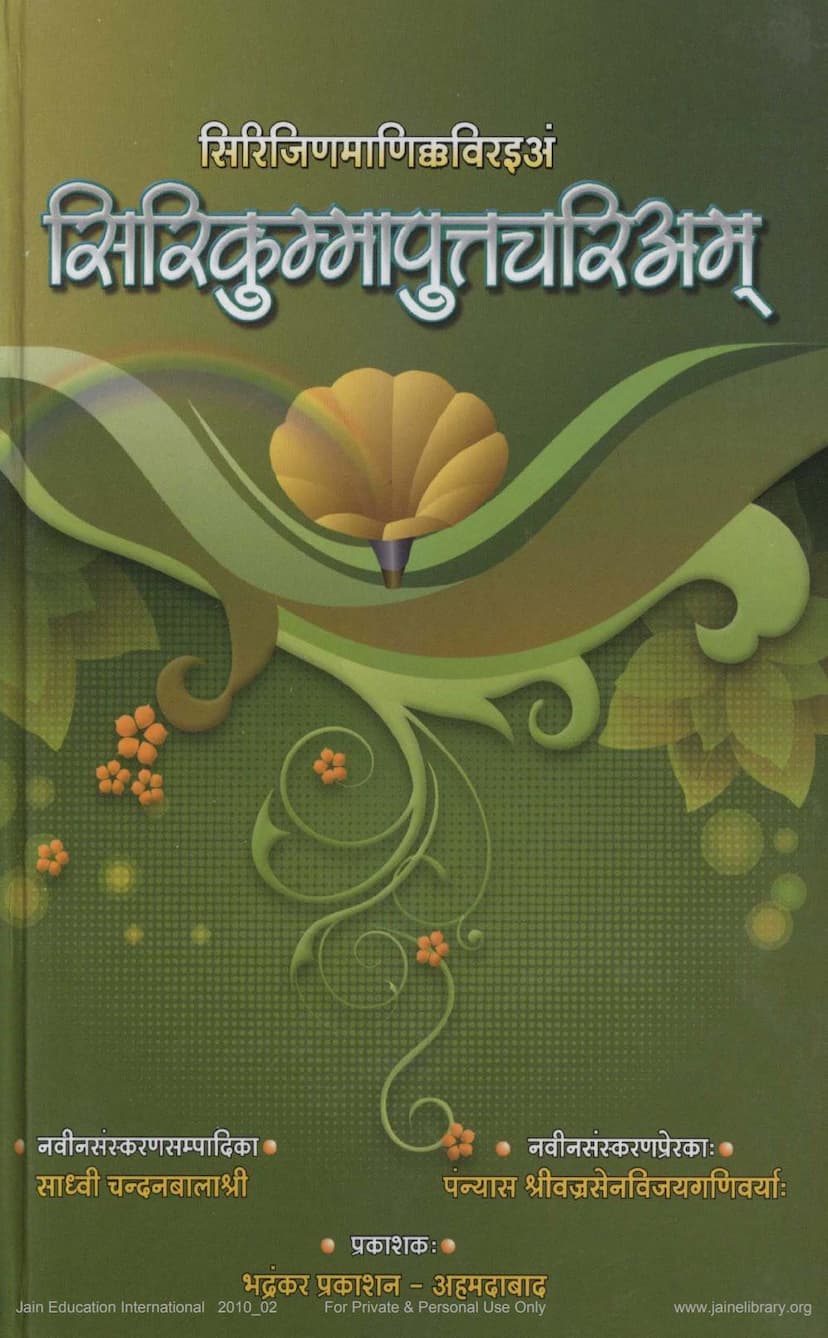Sirikummaputtachariam
Added to library: September 2, 2025

Summary
This Jain text, titled "Sirikummaputtachariam" (सिरिकुम्मापुत्तचरिअम्), is a collection of narratives and teachings centered around the concept of "Bhava Dharma" (भावधर्म), which emphasizes inner disposition and spiritual intention over external rituals.
Here's a comprehensive summary based on the provided text:
1. Title and Authorship:
- Title: Sirikummaputtachariam (सिरिकुम्मापुत्तचरिअम्)
- Original Author: Jinmanikyavijay (जिनमाणिक्यविजयमहाराजाः) - a disciple of Acharya Hemavimalasuri. The text also mentions that it might have been composed by his disciple, Ananthahamsavijay (अनंतहंसविजयमहाराजाः).
- New Edition: Compiled and edited by Sadhvi Chandanbalashreeji (साध्वी चन्दनबालाश्री).
- Inspiration for New Edition: Pannas Shri Vajrasenvijay Ganivarya (पंन्यास श्रीवज्रसेनविजयगणिवर्याः).
- Publisher: Bhadrankar Prakashan (भद्रंकर प्रकाशन), Ahmedabad.
- Publication Year: 2010 (February), with the new edition published in Vir Samvat 2535 / Vikram Samvat 2065 (corresponding to 2009 CE).
2. Content and Themes:
The book primarily focuses on the "Bhava Dharma" (भावधर्म - Dharma of inner disposition) and its profound influence, as illustrated through the life story of Dharmadeva-Kūrmāputra (धर्मदेव-कूर्मापुत्र).
- Bhava Dharma's Supremacy: The text repeatedly emphasizes that while Dharma can be understood as charity, austerity, conduct, and thought (भाव), it is the 'Bhava' (thought, inner disposition) that is the most potent and essential. It is the means to cross the ocean of existence, the path to heaven and liberation, and the wish-fulfilling divine gem for the virtuous.
- The Story of Kūrmāputra (Dharmadeva):
- Kūrmāputra (also known as Dharmadeva) was the son of King Drona and Queen Drumā in the city of Durgamapura.
- Despite being a prince and later achieving great renown, he attained Kevala Jnana (omniscience) while still in his household life. This extraordinary feat is attributed to his strong adherence to Bhava Dharma and his practice of pure spiritual contemplation, cultivated in past lives.
- The narrative recounts his past life as Prince Durlabha, who encountered a Yaksha female named Bhadramukhi. This encounter and his subsequent experience in a celestial palace, as well as his interactions with his parents and spiritual guides, highlight the workings of karma and the importance of spiritual discipline.
- Interestingly, Kūrmāputra chose to remain in household life even after attaining Kevala Jnana, out of deep filial devotion, to guide and enlighten his parents. This act of selfless love and responsibility is presented as a significant aspect of his virtuous character.
- The story also touches upon his parents' spiritual journey, their renunciation, and their eventual rebirth as gods.
- Illustrative Examples: The text uses various analogies and examples to explain the concepts of Dharma and the attainments possible through Bhava Dharma:
- The comparison of Dharma to the importance of compassion (daya) in achieving the true essence of charity, austerity, etc.
- The parable of the merchant seeking the Chintamani jewel to illustrate the difficulty of obtaining spiritual treasures and the importance of proper effort and divine grace.
- The story of Bharata Chakravarti, Ilāputra, and Āsādhabhūti, who attained Kevala Jnana through profound inner disposition (Bhava Dharma), often while still householders or in specific life circumstances.
- The text explains the concept of "Kshapaṇaśreṇi" (क्षपकश्रेणि), the ladder of spiritual progress leading to liberation, by detailing the stages of annihilating karmas.
- Multi-lingual Presentation: This edition is notable for its rich linguistic presentation, including:
- The original Prakrit text.
- A Sanskrit translation (Sanskrita Chāyānuvāda) by Pandit Hargovinddas.
- Gujarati and Hindi translations by Pandit Amrit Patel.
- An English translation by K. V. Abhyankar.
- This multi-lingual approach aims to make the text accessible to a wider audience.
- Appendices: The book includes several appendices providing further context and references:
- Parishishta 1: The story of Kūrmāputra from the Rishimandalavritti, composed by Shubhavardhangani.
- Parishishta 2: The story of Kūrmāputra from the Vivekamnjari commentary by Balachandrasuri.
- Parishishta 3: An alphabetical index of the verses (padyānamākārādyanukramaḥ).
- Parishishta 4: An alphabetical index of the quotations (uddhāraṇānamākārādyanukramaḥ).
- Parishishta 5: An alphabetical index of special names (viśeṣanāmnāmākārādyanukramaḥ).
- Manuscript Information: The preface also details the manuscripts used for the new edition, noting their sources and condition, and acknowledging the importance of earlier publications and editors.
3. Significance:
The "Sirikummaputtachariam" is presented as a valuable work for understanding and practicing "Bhava Dharma." It highlights that true spirituality lies in the purity of one's thoughts and intentions, which can lead to profound spiritual achievements, even within the confines of worldly life, as exemplified by Kūrmāputra. The meticulous editing and multi-lingual translation make it an important resource for Jain scholars and practitioners.